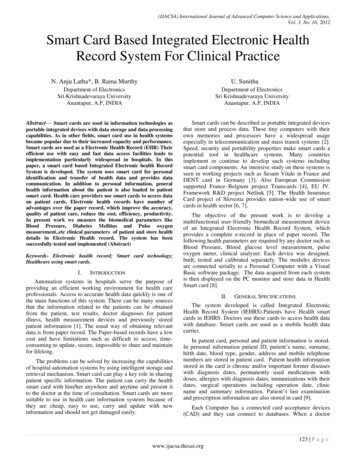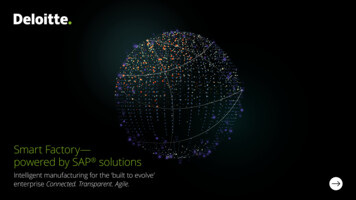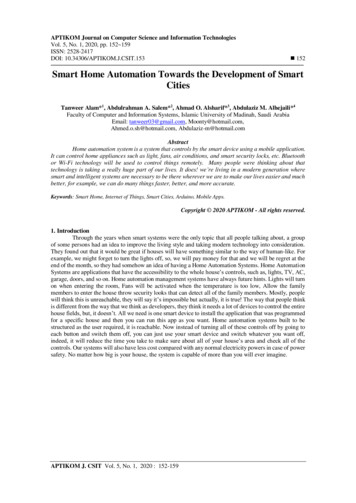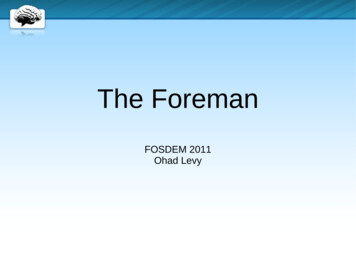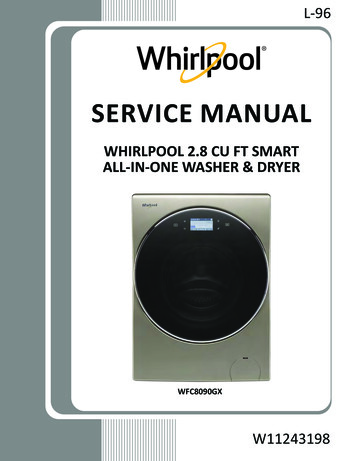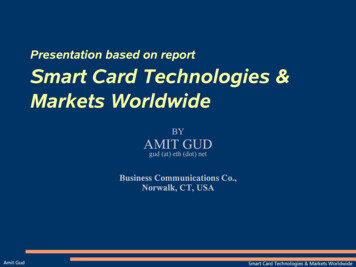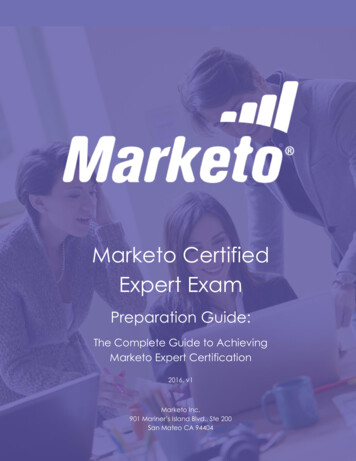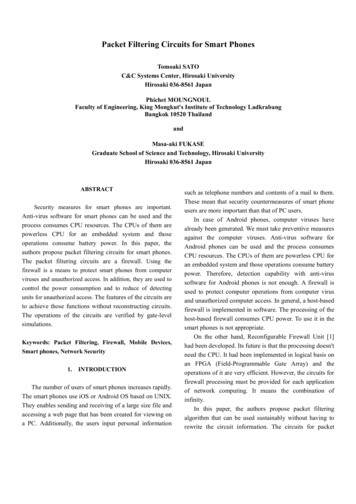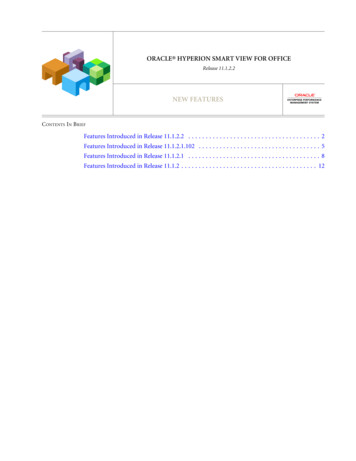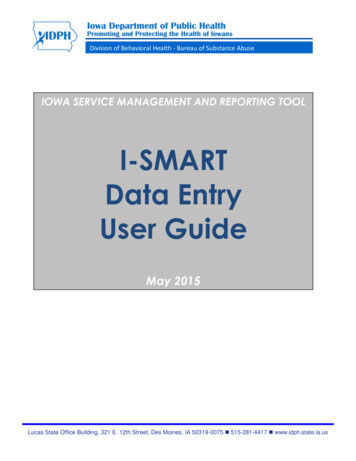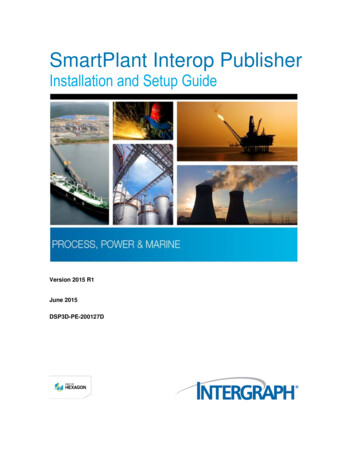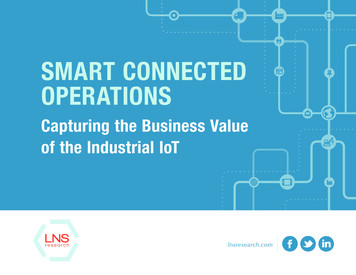
Transcription
SMART CONNECTEDOPERATIONSCapturing the Business Valueof the Industrial IoTlnsresearch.com
SMART CONNECTED OPERATIONSCapturing the Business Value of the Industrial IoTTABLE OF CONTENTSSection 1: Introduction, Research Demographics, Industry Drivers, Challenges. . . . . . . . . . . . . . . . . . . . . . . 3Section 2: OT Convergence and Adoption of Industrial IoT Platform . . . . . . . . . . . . . . . . . . . . . . . . . . . . . . . . . . 8Section 3: Transformation of Traditional Manufacturing System Architecture . . . . . . . . . . . . . . . . . . . . . . . . . . . 14Section 4: Smart Connected Operations:IoT Enabled Production, Quality, Inventory, and Maintenance . . . . . . . . . . . . . . . . . . . . . . . . . . . . . . . . . . . . . . . . . 19Section 5: How to Drive ROI and Get Started with IIoT . . . . . . . . . . . . . . . . . . . . . . . . . . . . . . . . . . . . . . . . . . . . . . . . . . 25Section 6: Summary and Recommendations . . . . . . . . . . . . . . . . . . . . . . . . . . . . . . . . . . . . . . . . . . . . . . . . . . . . . . . . . . 28lnsresearch.com
SECTION 1Introduction, ResearchDemographics, IndustryDrivers, Challenges
IntroductionPAGESmart Connected Operations is a future looking vision that describes4what the factory or production line of the future will look like. It willSMART CONNECTEDOPERATIONSinvolve Industrial Internet of Things (IIoT) enabled MOM applicationsTABLE OFCONTENTSSECTION1 2 34 5 6integrated with IIoT enabled assets and IIoT enabled business systems.It is an elemental part of creating the Smart Connected Enterprise and isoften where companies have breaks in the strands of the digital thread.In moving towards this vision, both solution providers and manufacturing organizations are goingto have to up the game when itSMART CONNECTED ENTERPRISEcomes to investing in IIoT. Theseinvestments will include the creation of new organizations thatbring together IT, OT, and business leaders, new technologiesCONNECTIVITYL5CLOUD Private/Public/HybridIoT Enabled Governanceand Planning Systems Network Infrastructure Wired, Wifi, and Cellular IaaS - Compute, Storage, Network Standards - Serial/Proprietary Ethernet/Open IPaaS - Run Time, Queue, Traditional DB/DW DataHistorian In-Memory Database Hadoop/Data Lake SaaS - Traditional Enterprise Applications, Next-Genwith the foresight to see that small Machine 2 Machine/DataAcquisition - Embedded,Gateways, APIs, Web Services,OPCUA, Modbus TCP/IP,MQTT, etc.pilot projects today could trans- Device Managementthat enable connectivity, cloud,big data analytics, and the development of new applications, alongform entire industries tomorrow.L4IoT Enabled BusinessSystemsIoT Enabled Applications Security - Authentication, Access Control, ConfigurationManagement, Antivirus/Spyware, Cryptography, Logging,Data Tagging, ComplianceSmart Connected Operations - IIoT EnabledL3Event Processing ComplexProduction, Quality, Inventory, Maintenance Alarms, Condition BasedMonitoringL2 L1 L0 Security - Authentication, Data Transport and SpeedAccess Control, IntrusionDetection/Prevention, Firewalls,Application Whitelisting,Antivirus/Spyware, Cryptography, Logging, Data Tagging,Compliance, etc.BIG DATA ANALYTICSSmart Connected Assets - Statistical Programming: R, SAS, SPSS Search, Text Mining, Data ExplorationIIoT Enabled Sensors, Instrumentation,Analytics: Image/Video, Time Controls,Series, Geospatial,Predictive Modeling, Machine Learning, etc.Assets, and Materials Statistical Process Control Optimization and Simulation Metrics and KPIs VisualizationAPPLICATIONDEVELOPMENTIIoT EnabledNext-Gen IIoTData Model andSystems Integrated DevelopmentEnvironment: JAVA, HTML5Execution Engine Workflow and BusinessLogic Modeler Collaboration, Social Mobile Search Security - Authentication,Access Control, ConfigurationManagement, Cryptography,Logging, Compliance
Research DemographicsPAGE5The survey data presented in this eBook is based on over ionsSMART CONNECTEDOPERATIONSManagement (MOM) online survey. Respondents have participatedin this research to access the resulting research reports and comefrom a broad range of industries, geographies, and company sizes.Respondents have shared insights on business objectives, challenges,the maturity of leadership and business process capabilities, the useof technology, and performance in operational and financial metrics.TABLE OFCONTENTSSECTION1 2 34 5 %15.0%COLOR BYCOMPANY REVENUESmall: 0 - 250MMMedium: 250MM - 1BBLarge: 1BB COLOR BY HQ LOCATIONCOLOR BY INDUSTRYNorth AmericaDiscrete ManufacturingEuropeF&B / CPGRest of the WorldLife SciencesAsia / PacificProcess Manufacturing
Industry DriversThe top strategic objectives in the manufacturing industry havecontinues to enable Smart Connected Products and move traditional6remained consistent for years, with many centered on servingmanufacturers from delivering traditional products like cars or jetcustomers. Industrial companies want to deliver customers highengines to IIoT enabled Products as a Service (PaaS) like on-demandquality products, and deliver them on time. They also want to betransportation or thrust.SMART CONNECTEDOPERATIONSPAGETABLE OFable to increase production capabilities and quickly introduce newproducts to the marketplace.Manufacturers continue to focus ondelivering value to customers.Over time it is likely that these customer focused objectives willremain at the top of the priority list. In fact, being customer focusedmay even become more important as IIoT technology innovationCONTENTSSECTION1 2 34 5 6Top Operational Objectives61%Ensuring consistent quality of products55%Responsiveness to customer order demands52%Increasing production capacity and capabilities42%Getting new products to market faster39%Tighter alignment of business and manufacturing goalsRegulatory Compliance38%Global alignment and standardization ofmanufacturing processes and reporting38%Improving environment, health, and safety performance32%Effective human resource skills and management32%0%10%20%30%40%50%60%
Industry ChallengesThe challenges that manufacturers face with achieving objectivesAs will be discussed in the rest of this eBook, just as IIoT technologies7span people, processes, and technology. This is informative in theare transforming the products manufacturers are delivering, they aresense that all three of these capabilities are highly dependent on eachalso transforming the information and operational technologies used toother for success, and a shortcoming in any one area can jeopardizeenable these solutions, and will hopefully provide new approaches tothe whole system. Without strong and well established leadership andachieve these objectives with greater success. In fact, we can begin toculture, robust process architecture and change management, andconsider people, processes, and technology in the context of the IIoT.new technology with a clear ROI, any manufacturing organization willIn this new paradigm both people and processes can be considered asstruggle to be world class and achieve business objectives.things along side more traditional “things” like sensors, instrumentation,SMART CONNECTEDOPERATIONSPAGETABLE OFCONTENTSSECTION1 2 34 5 6It is also worth noting that just as objectives have remained consistentmaterials, and assets.over time, so have the challenges in achieving them. Unfortunately, usingtraditional technology approaches has often left manufacturers coming upThe top challenges in manufacturing spanpeople, processes, and technology.short and attempting to solve the same problems in the same way over andover again while expecting a different result. It is no wonder that the pastdecade has left many wanting when it comes to manufacturing software.Top Operational Challenges48%Lack of collaboration across different departmentsIn this new IIoT paradigmthe distinction betweenpeople, processes, andtraditional “things” likesensors, instrumentation,materials, and assets,will melt away as newcyber-physical systemsare created.39%39%Disparate systems and data sourcesROI justifications for improvement investmentsTimely visibility into manufacturing performance metrics38%38%Lack of continuous improvement culture and processes38%Difficulty coordinating across supply and demand chains27%Lack of executive support26%Lack of available talent0%10%20%30%40%50%
SECTION 2IT – OT Convergenceand Adoption ofIndustrial IoT Platform
What Is the Industrial IoT?The Internet of Things (IoT) refers to the network of networks encom-Because of the legacy automation technology (also referred to as9passing the use of standard Internet Protocol (IP) technologies to connectoperational technology) and information technologies today, much ofpeople, processes, and “things” to enable new cyber-physical systems.which are based on proprietary communication protocols, the emergingof mobile technologies has increased over the past decades the connection (or inclusion) of people to the Internet has become commonplaceIoT for Extended Manufacturing Enterprise Value Chainsand ubiquitous.Over the past several years, and increasingly in the future (some estimate 50 billion connected things by 2020), physical things connected toMaterial, Component, andSub-Assembly Providersthe Internet will be the dominating force, including but not limited to,new IP enabled:SUPPLY&MADE1 2 34 5 6other areas of IoT and demand special attention.ND Devices Sensors Instrumentation MaterialsEnd ConsumersPublic & PrivateInternets Mobile and Fixed AssetsProduct, Service, andSolution Providers ProductsInterconnectingIoT IntelligenceThe Industrial Internet of Things (IIoT) should be understoodas a subset of the broader IoT, where the people, processes, andMDEmaintenance of physical assets.&PLYS UPthings are primarily engaged in the production of physical goods andNDSECTIONopen network of computers using standard IP technologies. As the usetechnologies, challenges, and use cases of the IIoT are unique to manyDEMATABLE OFCONTENTSTraditionally the Internet has been understood as the distributed andPLY&SMART CONNECTEDOPERATIONSPAGEANDPSUTransportation, Logistics,Distribution, and Retail Providers
IT – OT ConvergenceIt is not uncommon to hear in manufacturing circles that there is nothingIn the early days, IT-OT convergence could be understood mainly in10new when it comes to the IoT, or “machine-to-machine” (m2m). A pre-the context of moving from proprietary systems and a complete separa-vailing belief is that the industry has already been engaged in IoT andtion of IT and OT professionals, to beginning to use Microsoft technologym2m for many years and all of these “buzz words” are just re-character-on the shop floor and enabling collaboration between IT and OT groups.izations of existing trends that are long-standing and ongoing; namelyAs organizations and technology changed in the early 2000s, theSMART CONNECTEDOPERATIONSPAGETABLE OFCONTENTSSECTION1 2 34 5 6IT-OT convergence.original manifestation of IT-OT convergence continued, but new reali-LNS Research is clearly not in agreement with these nay-sayers andzations emerged, namely the convergence of plant and enterprise net-there is much evidence pointing to the contrary. It is true that the trendworks through the use of Ethernet on the shop floor and cross trainingof IT-OT convergence has existed for as long as IT and OT have beenof personnel.around. But it is also true that the way in which these technologies areToday, both of these manifestations of IT-OT convergence continueconverging is changing, as is the pace at which this is occuring.at differing rates, but a new third paradigm has emerged and it is allIT-OT CONVERGENCEaround the IIoT. As more and more things are connected, and as moreMATURITYand more cyber-physical systems like Smart Connected Assets and Smart Connected Operations become a Use of open standards based infrastructure(compute, storage, security) Formal Corporate IT and Operations collaboration Integration of Business Operations and Assets Use of open Ethernet based standards Cross training of IT and Automation IIoT Enabled Assets IIoT Enabled Operations IIoT Enabled Business Systems1970PLC (1969)19801990reality, industrial companies and the vendors servingthem will be forced to innovate and deploy these newIT-OT technologies at a rate not before seen in the industrial sector.OT, or Operational Technology,is a relatively new term describingthe long standing process controland automation technologiessupporting plant operations.200020102020TODAYWINDOWS (1985)ODVA (1995)INDUSTRY 4.0 (2011)2030
Adoption of IIoTPAGESince August of 2014 over 400 manufacturing executives have shared their11plans on the adoption and nature of interaction with the IIoT in industry.SMART CONNECTEDOPERATIONSNot surprisingly, the adoption of IIoT technology is still in the earlyadopter phase with 34% of companies currently investing or planning oninvesting in IIoT technologies over the next year. Clearly, the market is notyet in broad adoption and it is critical that these early adopters build clearbusiness cases and make good on ROI goals in these first projects.TABLE OFCONTENTSSECTION1 2 34 5 6Adoption of IIoTWe do not expect to invest in IoTtechnologies in the foreseeable future47%We do not expect to invest in IoTtechnologies in the next 12 months19%We expect to start investing in IoT technologies in thenext 12 months but are still establishing a budget15%We have made significant investment already and expectit to increase in the future9%We have established a budget for IoTtechnology investment in the next 12 months7%We have made significant investment already and expectit to stay the same for the foreseeable future2%We have made significant investment already and expectit to decrease in the future1%0%10%20%30%40%50%
Impact of IIoTPAGEWhen companies’ understanding and impact of the IoT is examined,12some additional interesting results emerge, especially on the connectionSMART CONNECTEDOPERATIONSof a lack of understanding of the IoT and the lack of adoption of IoT.TABLE OFIn fact, the overlap is astounding between the 47% of the market thatdoes not plan on investing in IoT in the foreseeable future and the 44%of the market that does not understand or know about the IoT. Thisresult highlights the second major challenge facing broad adoption forIoT in manufacturing, namely rapid education of industry leaders thatcurrently do not know or understand the IoT.CONTENTSSECTIONImpact of IIoT1 2 34 5 644%Don’t understand/know about IoTWe have interest but are stillinvestigating the impact21%We understand/are awarebut see no impact at this time16%We are rapidly pursuing IoT opportunities eitherfor operations, for customers, or both9%We see value to our operations and havestarted to invest in IoT technologies6%Our customer demands are causing us tostart to invest in IoT technologies4%0%10%20%30%40%50%
Crossing the Chasm in IIoTPAGEWhen these two major results on the adoption and education of IIoT13are considered together, the adoption of IIoT fits the traditional model13%SMART CONNECTEDOPERATIONSof technology adoption. The early market is currently testing the valueof IIoT and needs to prove the value of the IIoT over the coming months22%47%19%and years. The mainstream still needs to be educated quickly to promptadoption and cross the chasm, with the final 19% of the market that knowsabout the IIoT and still doesn’t want to invest now bringing up the rear.TABLE OFCONTENTS1 2 34 5 6looking to pilot. important to getquick, demonstratable winsstill doesn’t understand IIoT. importantto quickly educate and motivateknows and doesn’t careCrossing the Traditional Technology Chasm for the IIoTTHE CHASMSECTIONmoving forward todayTHE EARLYMARKETTHE MAINSTREAMN 680ENTHUSIASTSVISIONARIESPRAGMATISTS & CONSERVATIVESSKEPTICS13%22%47%19%
SECTION 3Transformation ofTraditional ManufacturingSystem Architecture
Traditional Value Chain Technology ArchitectureThe Purdue or ISA95 reference architecture has been used in the manu-When this realty is coupled with the fact that real-time systems on plant15facturing industry for decades to describe the different types of technol-networks collect data types and data at a pace that would overwhelmogy and business processes used across the enterprise.business systems, it becomes clear that without a dramatic step change inSMART CONNECTEDOPERATIONSPAGETABLE OFCONTENTSSECTION1 2 34 5 6At the top of the hierarchy are the decisions and business processesthat are the most high level, like management system governance, supplytechnology and architecture it is likely most companies will never achieveshop floor to top floor integration. Enter the IIoT Platform.chain planning, and product portfolio planning. At the bottom of the hierarchy is the physical world.If over time the adoption of technology, use of standards, and degreeUnfortunately, every company has dramaticallyof integration had grown homogeneously, the vision of shop floor to topdifferent levels of adoption and maturity across thefloor integration would be much closer to reality. Unfortunately, everyarchitecture, often making top floor to shop floorcompany has dramatically different levels of adoption and maturity acrossintegration impossible.the different levels, with most companies having broad adoption in ss systems and automationwith limitedadoptionin between.L5Governance and Planning SystemsL4Business SystemsL3Manufacturing Operations ManagementL2Equipment and Process ControlL1Sensors, Instrumentation, Data CollectionL0ADOPTION: ModerateADOPTION: BroadADOPTION: LimitedADOPTION: BroadADOPTION: BroadDECISIONS: Months/YearsDECISIONS: Days/WeeksNETWORK: EnterpriseNETWORK: EnterpriseDECISIONS: Seconds/Minutes/HoursDECISIONS: Sub-SecondDECISIONS: Sub-SecondProduction Assets and MaterialsNETWORK: Enterprise/PlantNETWORK: PlantNETWORK: PlantMODERATE INTEGRATIONCustom Web ServicesLIMITED INTEGRATIONCustom Web ServicesLIMITED INTEGRATIONProprietary Open, IP-BasedBROAD INTEGRATIONProprietary Open, IP-BasedBROAD INTEGRATIONProprietary Open, IP-Based
Industrial Internet of Things PlatformThe Industrial Internet of Things Platform as defined by LNS Research isFor the foreseeable future, the delivery of an IIoT Platform will come16a future looking framework for categorizing the technology capabilitiesthrough an ecosystem of vendors, most likely being a combination ofneeded to deliver IIoT solutions like Smart Connected Assets, Opera-large and established IT vendors, large and established Automationtions, and Enterprise.vendors, System Integrators, and emerging IIoT startups.SMART CONNECTEDOPERATIONSPAGETABLE OFCONTENTSSECTION1 2 34 5 6LNS Research sees four major buckets of capabilities making up theplatform:However, the preeminence of the ecosystem in the IIoT space shouldnot diminish the amount of innovation, speed, and aggressiveness manyvendors are demonstrating in the development of IIoT platforms. Manyvendors today have compelling offerings in two or three of the majorCONNECTIVITY includes the needed hardware and softwarerequirements categories and it may not be long before some vendorsfor networking in the plant and at the enterprise, the stan-move to have capabilities in all four.dards for integrating machines, clouds, and applications, andthe technology for quickly and efficiently managing devices,moving data, and triggering events.CLOUD includes the use of all types of clouds across the enterprise to put computing and storage capabilities where theyare most needed: at the edge, in the plant, at the enterprise,or outside the firewall.BIG DATA ANALYTICS includes the use of a broad set of statistical and optimization tools to cleanse, monitor, and analyzeboth structured and unstructured data for enabling neverbefore possible insights.APPLICATION DEVELOPMENT includes the needed tools forquickly and easily creating new mashup software applicationsthat leverage all other areas of the IIoT platform as well asquickly and easily moving existing legacy applications on topof the platform as well.Security is of utmost priority in industrialsettings and is not called out as a separatepart of the platform but instead built infundamentally across it.
PAGESMART CONNECTEDOPERATIONS17TABLE OFCONTENTSSECTION1 2 34 5 6INDUSTRIAL INTERNET OF THINGS PLATFORMCONNECTIVITYCLOUD Network Infrastructure Wired, Wifi, and Cellular Private/Public/Hybrid Standards - Serial/Proprietary Ethernet/Open PaaS - Run Time, Queue, Traditional DB/DW DataHistorian In-Memory Database Hadoop/Data Lake Machine 2 Machine/DataAcquisition - Embedded,Gateways, APIs, Web Services,OPCUA, Modbus TCP/IP,MQTT, etc. SaaS - Traditional Enterprise Applications, Next-GenIoT Enabled Applications Device Management IaaS - Compute, Storage, Network Security - Authentication, Access Control, ConfigurationManagement, Antivirus/Spyware, Cryptography, Logging,Data Tagging, Compliance Complex Event Processing Alarms, Condition BasedMonitoring Data Transport and Speed Security - Authentication,Access Control, IntrusionDetection/Prevention, Firewalls,Application Whitelisting,Antivirus/Spyware, Cryptography, Logging, Data Tagging,Compliance, etc.APPLICATIONDEVELOPMENT Integrated DevelopmentEnvironment: JAVA, HTML5 IIoT Data Model andExecution Engine Workflow and BusinessLogic Modeler Collaboration, Social MobileBIG DATA ANALYTICS Statistical Programming: R, SAS, SPSS Search, Text Mining, Data Exploration Analytics: Image/Video, Time Series, Geospatial,Predictive Modeling, Machine Learning, etc. Statistical Process Control Optimization and Simulation Metrics and KPIs Visualization Search Security - Authentication,Access Control, ConfigurationManagement, Cryptography,Logging, Compliance
Smart Connected EnterprisePAGELegacy is the name of the game in manufacturing technology. Althoughcontrols, assets, and materials. This IoT enablement is what will trigger the18manufacturing is hot and many new plants are being built to bringemergence of “Smart Connected” Assets and Operations.SMART CONNECTEDOPERATIONSoperations closer to the point of consumption, the biggest opportunitySecond, the creation of IoT enabled next-generation systems willenable true shop floor to top floor integration and mashup applications byremains modernizing existing plants and assets.As described above, shop floor to top floor integration has proven overeliminating the dependency of unbroken integration between traditionalthe past 30 years to be largely an intractable problem; the IIoT Platformsystems and allowing for the flow of data to and from anywhere in wayswill change this in two ways.that make sense given limitations of legacy systems and the use cases forFirst, the traditional architecture will begin to converge and flatten asnew business models.solution providers port or re-write existing applications to run on top ofThe combination of IIoT enabled legacy systems and IIoT enabledCONTENTSIIoT platforms. Moving forward, it is likely that there will be vendors talkingnext-generation systems is the foundation for enabling the smartSECTIONmuch more CONNECTEDabout IoT enabled MOM,MES, sensors, instrumentation,SMARTENTERPRISEconnected enterprise.TABLE OF1 2 34 5 6CONNECTIVITYL5CLOUD Private/Public/HybridIoT Enabled Governanceand Planning Systems Network Infrastructure Wired, Wifi, and Cellular IaaS - Compute, Storage, Network Standards - Serial/Proprietary Ethernet/Open IPaaS - Run Time, Queue, Traditional DB/DW DataHistorian In-Memory Database Hadoop/Data Lake Machine 2 Machine/DataAcquisition - Embedded,Gateways, APIs, Web Services,OPCUA, Modbus TCP/IP,MQTT, etc. SaaS - Traditional Enterprise Applications, Next-GenL4IoT Enabled BusinessSystemsIoT Enabled Applications Security - Authentication, Access Control, ConfigurationManagement, Antivirus/Spyware, Cryptography, Logging,Data Tagging, ComplianceSmart Connected Operations - IIoT EnabledL3Event Processing ComplexProduction, Quality, Inventory, Maintenance Device Management Alarms, Condition BasedMonitoringL2 L1 L0 Security - Authentication, Data Transport and SpeedAccess Control, IntrusionDetection/Prevention, Firewalls,Application Whitelisting,Antivirus/Spyware, Cryptography, Logging, Data Tagging,Compliance, etc.BIG DATA ANALYTICSSmart Connected Assets - Statistical Programming: R, SAS, SPSS Search, Text Mining, Data ExplorationIIoT Enabled Sensors, Instrumentation,Analytics: Image/Video, Time Controls,Series, Geospatial,Predictive Modeling, Machine Learning, etc.Assets, and Materials Statistical Process Control Optimization and Simulation Metrics and KPIs VisualizationAPPLICATIONDEVELOPMENTIIoT EnabledNext-Gen IIoTData Model andSystems Integrated DevelopmentEnvironment: JAVA, HTML5Execution Engine Workflow and BusinessLogic Modeler Collaboration, Social Mobile Search Security - Authentication,Access Control, ConfigurationManagement, Cryptography,Logging, Compliance
SECTION 4Smart ConnectedOperations: IoT EnabledProduction, Quality, Inventory,and Maintenance
Strategic Objective for Operational TechnologyPAGEWhen it comes to the top objectives manufacturers have today for oper-20ational technology, the number one is the analysis of accurate, relevantthe biggest gaps manufacturers have today, namely: Effectively using manufacturing data (much of which never leavesthe legacy application for analysis)SMART CONNECTEDOPERATIONSdata for better decision making, followed closely by IT-OT collaborationand improving the usability of technology. Collaboration between IT and OT (which may not exist at all or can evenbe contentious)These goals clearly support many of the business objectives discussed earlier around supply chain efficiency and rapid new product Lack of consumer grade qualities in manufacturing technology likemobility, search, and personalizationdevelopment. These goals can also be thought of in context of many ofTABLE OFCONTENTSTop Objectives for Operational TechnologySECTION1 2 34 5 644%Analysis of accurate, relevant data33%32%Improve collaboration between IT and OTImprove usability of technology27%23%Enhance knowledge capture from workers and systemsSystem modernization22%Enable mobility within operations19%Remote monitoring of critical assets and process15%Increase deployment of Cloud15%14%Improve cyber, network, and physical securityDeployment of intelligent systems8%Move towards open IP based networking standards4%Deployment of 3D Printing0%10%20%30%40%50%
Modernizing Legacy SystemsPAGESince the publication of the MOM Best Practices Guide, LNS Researchdevelopment the entire market will shift or be left behind. This move to21has been promoting the idea of a MOM Integration and CollaborationIIoT enabled MOM applications will promote:SMART CONNECTEDOPERATIONSPlatform. Rather than investing in separate applications with separateTABLE OFdatabase structures, integration requirements, and user interfaces, aplatform approach brings a common and standardized set of servicesfor deploying MOM applications.Over time MOM vendors have to a varying degree pursued this approach, but it is likely that as early adopters of IIoT enable their offeringsby building in connectivity, cloud, big data analytics and applicationIncreasing open IP standards based integrationIncreasing analytics and optimization at the edgeIncreasing use of mobile, social (including videoand collaboration), and cloudRemote monitoring and accessClosed-loop business processesCONTENTSSECTION1 2 34 5 6Future - Integration & Collaboration PlatformsEnterprise ApplicationsESB, s/Apps:Time & seModules/Apps:EMI / OI, ReportingCOMMON APPLICATION FUNCTIONALITY PROVIDED BY MOM PLATFORMS:ApplicationIntegrationSecurity& AccessConfiguration:Platform Services,Modules/AppsModules/Apps:Execution, TrackingStandards, ProprietaryIndustrial AutomationUnified Asset& Production ModelUnified OperationsDatabase & HistorianModules/Apps:Asset Tracking,MRO, RCMModules/Apps:OEE, QualityGlobal Deployment& LicensingIntegrated DevelopmentEnvironmentCollaboration& WorkflowVisualization& Mobility
Implementing Next-Gen IIoT SystemsPAGEIoT Enabled Next-Gen Systems include mashup applications that will22be able to integrate data, people, workflows, and legacy systems withSMART CONNECTEDOPERATIONSapplications and Web services from outside the firewall. These Next-TABLE OFCONTENTSSECTION1 2 34 5 6Gen systems will be able to break down traditional architectures byfacilitating this integration with a “from anywhere to anywhere” approach that will eliminate the need for information to flow throughsystems in an unnatural way. This will allow for the development ofspecific use cases, including: Shop floor to top floormashup applications Traceability and genealogysystems (includingserialization)IIoTEnabled New business modelNext-Genenablement, SmartSystemsConnected Products,Products as a Service (PaaS) Remote monitoringand access Closed-loop businessprocessesSMART CONNECTED ENTERPRISECONNECTIVITYL5CLOUD Private/Public/HybridIoT Enabled Governanceand Planning Systems Network Infrastructure Wired, Wifi, and Cellular IaaS - Compute, Storage, Network Standards - Serial/Proprietary Ethernet/Open IPaaS - Run Time, Queue, Traditional DB/DW DataHistorian In-Memory Database Hadoop/Data Lake Machine 2 Machine/DataAcquisition - Embedded,Gateways, APIs, Web Services,OPCUA, Modbus TCP/IP,MQTT, etc. SaaS - Traditional Enterprise Applications, Next-GenL4IoT Enabled BusinessSystemsIoT Enabled Applications Security - Authentication, Access Control, ConfigurationManagement, Antivirus/Spyware, Cryptography, Logging,Data Tagging, C
As will be discussed in the rest of this eBook, just as IIoT technologies are transforming the products manufacturers are delivering, they are also transforming the information and operational technologies used to enable these solutions, and will hopefully provide new app
